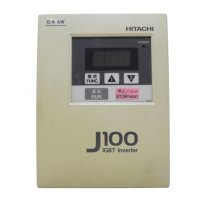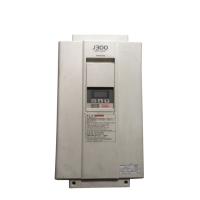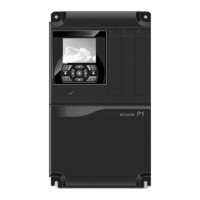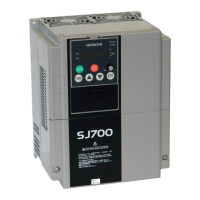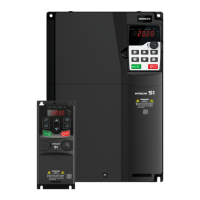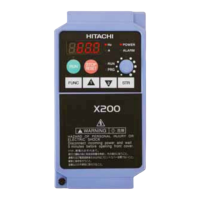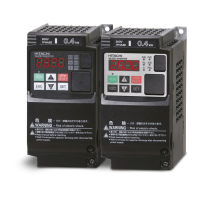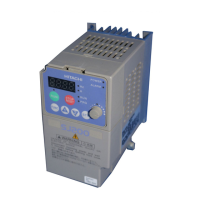Do you have a question about the Hitachi J100 E4 SERIES and is the answer not in the manual?
Explains the general safety alert symbol used in the manual.
Defines the "WARNING" signal word and its meaning.
Defines the "CAUTION" signal word and its meaning.
Defines the "NOTE" signal word for special emphasis.
Details safety precautions when working with high voltage.
Lists essential safety precautions for installation and operation.
Discusses compliance with EMC directives for inverter use in the EU.
Details specific installation requirements for EMC compliance.
Explains the naming convention for filter models.
Provides detailed specifications for single and three-phase inverters.
Details wiring requirements for power supply and motor connections.
Describes the proper wiring for signal connections.
Illustrates the process of mounting a filter to the inverter.
Shows how to connect wiring to the inverter terminals.
Demonstrates alternative wiring configurations for the inverter.
Illustrates the process of mounting a filter to the inverter.
Shows how to connect wiring to the inverter terminals.
Demonstrates alternative wiring configurations for the inverter.
Specifies input voltage requirements for safe operation.
Details safe installation locations and surface requirements.
Advises against connecting power supply before wiring is complete.
Warns against inserting foreign objects into the inverter.
Discusses operating general purpose motors at high frequencies.
Describes testing procedures for voltage and insulation resistance.
Illustrates the use of a megohm-meter for testing.
Advises on safe wiring and connector handling during operation.
Discusses stopping operation by switching electromagnetic contactors.
Explains behavior during instantaneous power failure and auto-restarting.
Warns against inserting capacitors or surge absorbers between terminals.
Emphasizes the importance of grounding the terminal.
Explains the meaning of the CHARGE lamp after power off.
Details a filter for suppressing surge voltage in 400V class inverters.
Discusses methods to reduce noise interference from the inverter.
Explains how distributor lines can affect inverter operation.
Explains actions to take when an EEPROM error occurs.
Advises on safe wiring and connector handling during operation.
Lists checks to perform before installation and wiring.
Advises verifying the product against the order.
Explains the information on the inverter's specifications label.
Details how to remove and reattach the inverter's front cover.
Identifies and labels the various parts of the inverter.
Specifies vertical mounting and required clearances around the inverter.
Provides guidance on mounting the inverter on a wall.
Warns against debris entering the inverter during wiring.
Advises checking ambient temperature and its impact on inverter life.
Recommends installing the inverter in a box for proper ventilation.
Notes that the front cover should not be removed for EMC directives.
Details how to wire the power supply and motor to the inverter.
Lists input voltage and terminal specifications for wiring.
Illustrates the terminal connections for the control circuit.
Provides important notes regarding control circuit wiring and breakers.
Explains proper and improper grounding methods.
Specifies wire types and lengths for signal connections.
Discusses insulating signal lines.
Shows connection diagrams for programmable controllers.
Provides a sample wiring configuration with components and their specifications.
Discusses wire length recommendations for specific applications.
Details the function of various parts like filters and resistors.
Identifies and describes the main circuit terminals.
Identifies and describes the control circuit terminals.
Provides dimensions for main and control circuit terminals.
Specifies the recommended tightening torque for terminals.
Lists terminal symbols, their descriptions, and initial settings.
Provides additional remarks for control circuit functions.
Lists crucial checks to perform before starting inverter operation.
Outlines the steps for conducting a test run of the inverter.
Lists checks to perform after the test run is complete.
Mentions factory default settings for frequency and operation.
Details the functions of various intelligent input terminals.
Describes terminal symbols, functions, and their contents.
Explains the function and setting of FM and CM1 terminals.
Details the function and precautions for the reverse/stop terminal.
Explains settings for multispeed control using specific terminals.
Illustrates how to set multispeed options.
Shows how output terminals are connected for multispeed.
Describes the function of the external DC damping terminal.
Explains how to execute DC braking.
Details the procedure for initializing the equipment to factory settings.
Explains how to set two types of motor controls and select settings.
Lists functions that can be configured using the second function setting.
Describes the method for setting terminals.
Explains how to enable acceleration/deceleration by 2 stages.
Describes how to switch functions for acceleration and deceleration.
Details the inverter's behavior when the free run stop terminal is activated.
Explains how the inverter enters a trip state upon external trip signal.
Describes the function of preventing restart after power-on.
Notes about USP error and running command input.
Explains how the trip history can be canceled or cleared.
Describes the method for setting the reset terminal.
Details how the software lock prevents changes to functions.
Explains how frequency arrival signals are outputted.
Shows an example of connecting output terminals for arrival signals.
Describes the output of a RUN signal when the motor is driven.
Explains how terminals output a signal when output current exceeds the set value.
Details how alarm signals are outputted when an inverter fault occurs.
Lists the contact specifications for alarm output terminals.
Identifies and describes the functions of the keys on the digital operator.
Provides a step-by-step guide to operating the inverter using the digital operator.
Explains how to use the Function key for various settings.
Details how to use Up and Down keys for data adjustment.
Explains the function of the RUN key for starting.
Describes the STOP/RESET key for stopping and resetting.
Clarifies how screen displays indicate settings and parameters.
Lists functions and their initial settings for monitor and function modes.
Lists extended functions and their settings.
Lists extended functions and their settings.
Explains the monitor and function modes with command displays.
Details how to set the output frequency for the inverter.
Explains how to set the motor's running direction.
Describes how to select different V/F patterns for motor control.
Details special V/F patterns for specific applications.
Explains how to set acceleration and deceleration times.
Details how to adjust the torque boost for motor starting.
Describes the process of adjusting the analog meter.
Explains how to set the voltage supplied to the motor.
Details how to monitor trip history and alarm causes.
Explains how to set the control method for the motor.
Details setting motor capacity and number of poles.
Describes how to adjust maximum and base frequencies.
Details the setting of the base frequency.
Explains how to adjust the start frequency.
Details setting upper and lower frequency limits.
Describes how to set jump frequencies to avoid resonances.
Explains the setting of the carrier frequency.
Details how to set multiple speed levels for the motor.
Explains setting 2-stage acceleration and deceleration times.
Describes DC braking function settings and force adjustment.
Details how to enable or disable DC braking.
Explains setting the electronic thermal sensor level.
Describes setting the overload limiting signal ratio.
Details setting overload limits and deceleration rates.
Explains the content selection for overload limiting.
Details enabling or disabling the LAD stop function.
Describes retry operation after inverter trips.
Explains selecting receiving voltage during deceleration.
Details setting motor voltage during deceleration.
Explains setting the usage ratio for dynamic braking.
Sets output signal frequency for acceleration and deceleration.
Selects the method for outputting frequency arrival signals.
Selects the output mode for the RUN signal.
Selects the output mode for the overload notice signal.
Enables or disables frequency setting changes in Soft Lock status.
Clears trip history.
Enables or disables soft-start with reduced voltage.
Adjusts frequency command relationship with inverter output.
Sets allowance time for undervoltage and retry waiting.
Enables or disables data rewriting.
Assigns functions to input terminals.
Assigns functions to output terminals.
Sets contact types for input terminals.
Sets contact types for output and alarm terminals.
Describes protection against overcurrent and motor lock.
Details protection against motor overload.
Explains protection against braking resistor overload.
Describes protection against over-voltage.
Explains protection against EEPROM errors.
Details protection against undervoltage.
Explains protection against CT errors.
Describes protection against CPU errors.
Explains protection against external trips.
Details protection against USP errors.
Explains protection against ground faults.
Shows examples of various display contents and their meanings.
Lists probable causes and countermeasures for the inverter not running.
Addresses issues with motor RPM not increasing or being unstable.
Discusses probable causes and solutions for incorrect data.
Explains why data might not be changeable and how to resolve it.
Provides precautions to take when setting data.
Lists precautions for performing maintenance and inspection safely.
General advice on keeping the unit clean and ensuring connections are firm.
Outlines daily, periodic, and resistance tests for inspection.
Details procedures for insulation resistance and withstand voltage tests.
Details inspection items, methods, criteria, and instruments.
Continues detailing inspection items, methods, criteria, and instruments.
Final part detailing inspection items, methods, criteria, and instruments.
Lists measurement items, parts, instruments, and reference values.
Lists model designations and their maximum motor capacity.
Details rated input voltage and rated output current for models.
Provides frequency accuracy and setting resolution.
Lists overload capacity, acceleration/deceleration times, and starting torque.
Explains dynamic braking and DC injection braking specifications.
Details input signal types, functions, and settings.
Describes output signal types, functions, and their characteristics.
Lists various protection functions available in the inverter.
Covers ambient temperature, humidity, vibrations, and paint color.
Lists available options and their applications.
Illustrates torque characteristics for different control methods.
Shows how to measure output voltage with and without load.
Provides notes and diagrams for terminal connections and functions.
Shows dimensional drawings and tables for specific models.
Provides dimensional drawings and panel cutout information for various models.
Details how to connect the optional remote operator to the inverter.
Explains setting up the remote operator using switches.
Lists display sequences and monitor names with their content and settings.
Details functions, settings, and ranges for various modes.
Details function names, settings, and remarks.
Details function names, settings, and remarks.
Details settings for intelligent terminal inputs and outputs.
Explains settings for external frequency commands and sampling.
Details the V/F pattern setting with examples.
Lists protective functions and their display codes when using the remote operator.
Shows dimensional drawings for remote operator and copy unit.
Illustrates the J100 series cable and connectors.
Details the procedure for copying data between inverters.
Explains changing and transferring data to other inverters.
Lists settings that cannot be copied using the copy function.
Lists information needed when reporting inverter trouble.
Details the warranty period and conditions.
Lists function names and standard settings for the digital operator.
Lists extended functions and their standard settings.
Details settings for intelligent terminal inputs and outputs.
Lists monitor names, display content, and set values for the remote operator.
Details functions, settings, and values in function mode.
Details settings for intelligent terminal inputs and outputs.
